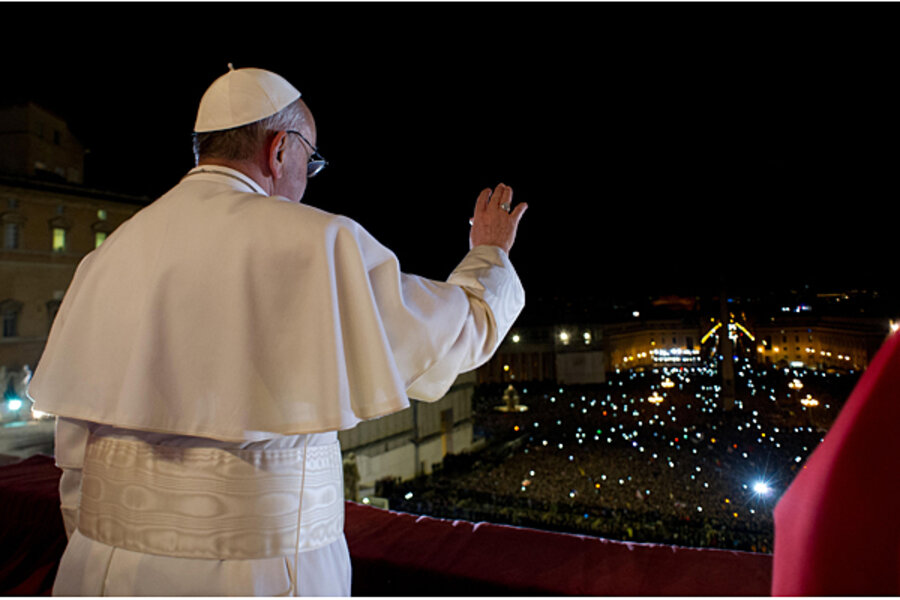Pope Francis signals core mission – returning Catholics to the church
As Pope Francis appeared on the Vatican balcony Wednesday night and prepared to offer his first blessing as pope, he signaled a priority for his pontificate: renewing Catholic faith in places where it’s lost much of its luster.
“My hope is that this journey of the Church that we begin today … be fruitful for the evangelization of this beautiful city,” Pope Francis said, speaking in Italian.
It was no offhand remark, observers say. They expect Francis to vigorously champion the New Evangelization, which involves bringing lapsed and inactive Catholics back into the rhythms of church life, including regular mass attendance. Doing so would carry on a legacy of Popes John Paul II, who coined the term “New Evangelization,” and Benedict XVI, who made it a priority in a bid to counter secularization in the West.
“The election of this pope represents the determination of these cardinals [to make] the New Evangelization the great priority of our time,” says Matthew Bunson, a Catholic journalist, historian, and author of a forthcoming biography of Pope Francis. The new pope has been a champion of the New Evangelization, Mr. Bunson says, as a key to overcoming materialism and other spiritual deficiencies of these times.
But questions of interpretation remain to be sorted out as the church moves to practice the New Evangelization in vastly diverse settings, from Paris to New York, Manila to Nairobi. Guiding the process is no longer a German scholar deeply familiar with academic challenges to faith, as Benedict was, but instead an Argentine who’s watched his continent’s religious landscape be transformed by Catholic migration to Pentecostalism.
The new pope’s sensibilities will be tested, observers say, on the matter of how much latitude to give local bishops for interpretation. John Paul II and Benedict XVI insisted that all settings proclaim Christ as the universal savior, for instance, even though Asian churches resisted the teaching on grounds that it was offensive in their cultures, according to Rev. Thomas Rausch, a Jesuit theologian at Loyola Marymount University in Los Angeles.
“As these churches of Asia, Latin America, and Africa begin to find their own voices, there’s going to be more tension with the Roman center,” Professor Rausch says.
Catholic communities are sorting out how and where to reengage the faithful. The Archdiocese of Boston, for instance, is currently reorganizing its 275 parishes into clusters. The idea: by sharing priests and staffs among two, three, or four parishes, churches can free up resources for reaching out to inactive Catholics and for encouraging more boys and men to explore the priesthood as a vocation. In this model, parishes become centers for the New Evangelization.
Catholic colleges and universities are being called upon to play a larger role as well. At The Catholic University of America on March 16, the United States Conference of Catholic Bishops’ Committee on Doctrine will lay out its vision for how Catholic universities can help evangelize Catholic students who might be wandering away from their faith roots. Among the potentially controversial issues is whether theologians will see evangelism as consistent with their roles as teachers.
Wherever outreach efforts are focused, indifference poses challenges. In America, only 23 percent of Catholics attend mass weekly or more often, according to a 2008 survey by the Center for Applied Research on the Apostolate. In another measure, just 27 percent of American Catholics claim a strong religious identity, down from 46 percent four decades ago, according to a Pew Research Center analysis of General Social Survey data.
Pope Francis is aware, Bunson says, that faith-eroding forces have taken a toll on spiritual formation worldwide. He’s apt to take the New Evangelization to the ends of the Earth and sort out details along the way.
“If consumerism and other aspects of secularism are becoming global phenomena, then the New Evangelization has to have a global component,” Bunson says. “Benedict was concerned with the impact of evangelization in Europe in particular, [but] Francis is going to have a more global approach to the issue.”





